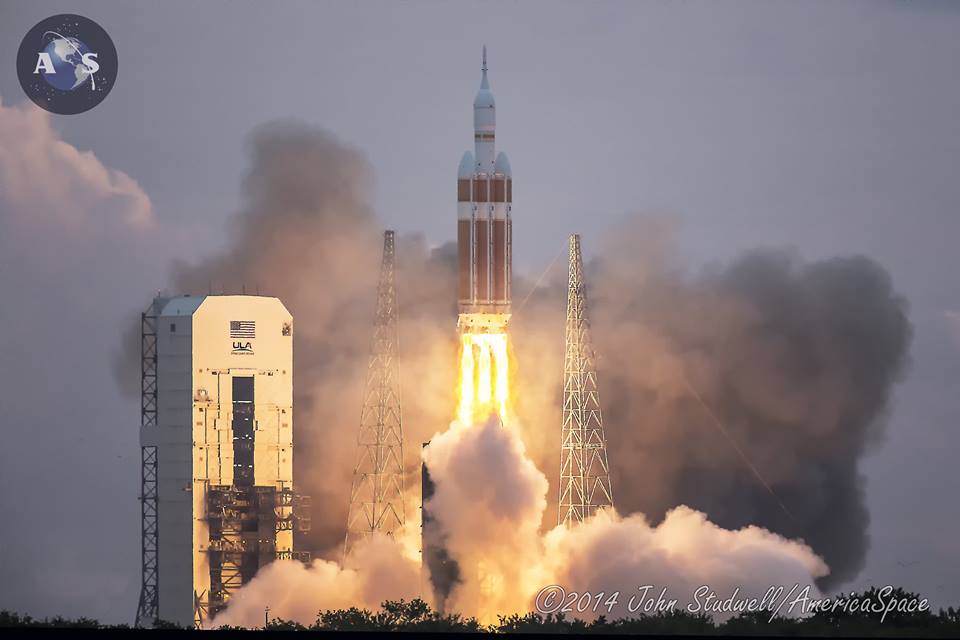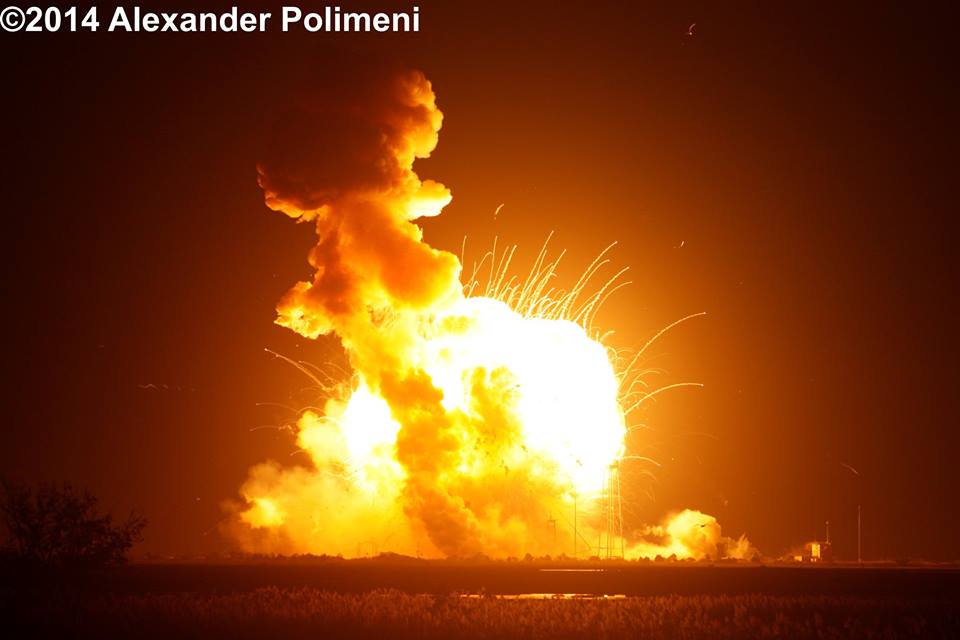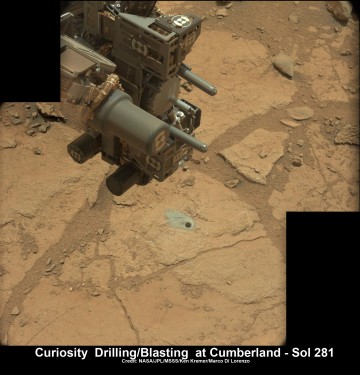
As 2014 winds down to its end, this year can be remembered for its new beginnings in spaceflight, encompassing the long-awaited U.S. Commercial Crew selection, Orion’s first test flight aboard a United Launch Alliance (ULA) Delta IV Heavy launch vehicle, Europe’s ushering in mankind’s first-ever robotic landing on a comet, and ongoing strides in the development in new launch vehicles and space systems internationally. While commercial space did face some adversity this year (particularly in late October) and the U.S. is still a few years away from sending human crews back to space, this year did prove to fuel excitement for spaceflight’s future, both human-helmed and unmanned.
Here is a survey of this year’s highlights in space.
Orion Blasts Off, Marking Dawn of New Era in U.S. Spaceflight
On Friday, Dec. 5, onlookers adjacent to Cape Canaveral Air Force Station (CCAFS) and millions worldwide (through television and Internet streams) watched as an Orion capsule was launched aboard ULA’s Delta IV Heavy launch vehicle for Exploration Flight Test 1 (EFT-1). The Orion capsule was sent on a high-apogee voyage on its second orbit to test its systems as it transited through the Van Allen radiation belts, and to propel it back to Earth for a high-energy reentry clocking in at 20,000 mph. Approximately 4.5 hours after launch, Orion splashed down in the Pacific Ocean off the coast of Baja, Calif., winding up a right-down-the-line test flight.
On Dec. 18, the capsule was returned to Kennedy Space Center in Florida for further analyses, which will be critical in further developing and refining “America’s spacecraft.” In 2018, space buffs can look forward to Exploration Mission 1 (EM-1), an integrated test of Orion, its service module (developed by the European Space Agency, or ESA), and the Space Launch System (SLS) launch vehicle, billed as the Saturn V’s successor.
Selections Made in Commercial Crew Program

In mid-September, NASA announced the selection of both Boeing’s CST-100 spacecraft and SpaceX’s Dragon V2 capsule to restore the United States’ capability to send crews to the International Space Station (ISS), which ended with the completion of the space shuttle program in 2011. Since that time, the U.S. has relied on Russia’s Soyuz spacecraft to visit the space station. It is hoped the U.S. will be able to return human crews to space aboard such vehicles as early as 2017.
In an article written by AmericaSpace’s Mike Killian, it was stated, “The total award value of their Commercial Crew Transportation Capability (CCtCap) contracts are worth up to $6.8 billion, with $4.2 billion for Boeing and $2.6 billion for SpaceX, and in order to achieve final NASA certification by 2017 both Boeing and SpaceX must meet the same rigorous safety standards that were required for the space shuttle.”
ESA’s Rosetta Orbits Comet, Deploys Lander in First-Ever Cometary Touchdown
On Aug. 6, ESA’s Rosetta spacecraft, which launched from the Guiana Space Centre in Kourou, French Guiana, in 2004, entered into the history books when it became the first spacecraft to orbit a comet (67P/Churyumov–Gerasimenko). Images from the comet revealed an alien world unlike humanity had ever seen, as the comet revealed a craggy surface and possesses a distinctive, double-lobed shape.

On Nov. 12, the world rejoiced as Rosetta’s lander, Philae, landed (not just once, but three times) on the comet. Despite landing in an area that caused its batteries to quickly deplete, Philae completed and submitted its entire science package before it “fell asleep” on Nov. 15. At present time, Rosetta’s science team is planning on making an “ultra close flyby” with the surviving orbiter. It is hoped the data from 67P/Churyumov–Gerasimenko will continue to reveal discoveries about how our Solar System was formed and, of course, about the unexpected nature of comets.
MAVEN Enters Mars’ Orbit
On Sunday, Sept. 21, NASA’s Mars Atmosphere and Volatile Evolution (MAVEN) spacecraft entered Mars’ orbit. According to a previous AmericaSpace article written by Ken Kremer, the spacecraft will “conduct the first detailed study of the planet’s tenuous upper atmosphere and … unlock mysteries on its habitability.” He added, “MAVEN arrived after a trouble-free and fantastic 10-month interplanetary voyage of 442 million miles from Earth to the Red Planet.”
In December, Kremer provided a MAVEN update, pointing at discoveries that may unlock new perspectives on Mars: “Initial findings from MAVEN are starting to provide clues on a new process by which the solar wind penetrates the atmosphere and contributes to how Mars lost its atmosphere and ability for liquid water to exist on the surface over time. Liquid water is a prerequisite for the formation and evolution of life as we know it.”
Antares Rocket Suffers Failure at Wallops Island

Unfortunately, this year was not without some setbacks. On the evening of Tuesday, Oct. 28, Orbital Sciences Corporation lost an Antares launch vehicle as it exploded just seconds after liftoff from Pad 0A at the Mid-Atlantic Regional Spaceport (MARS) in Wallops Island, Va. Its payload, a Cygnus cargo ship meant to dock with the ISS (christened the Spaceship Deke Slayton, named after the late Mercury 7/Apollo-Soyuz astronaut), was lost. While the investigation into what caused the explosion is ongoing, Orbital announced that it would proceed with 2015/2016 cargo launches utilizing ULA’s Atlas V launch vehicles until Antares’ engines were upgraded by late 2015/early 2016.
The same week, on Friday, Oct. 31, tragedy struck over the Mojave Desert in California as Virgin Galactic’s SpaceShipTwo broke up and crashed shortly after starting its powered flight, resulting in the death of one pilot and injuries to the other. The investigation into this incident is also ongoing.
Positively, commercial space enjoyed several successes this year, as SpaceX made two Commercial Resupply launches to the ISS (CRS-3 and CRS-4). Orbital also had two successful resupply missions before October’s launch failure, launching two Cygnus cargo spacecraft to the ISS.
United Launch Alliance Marks 14 Launches in 2014
United Launch Alliance (ULA) lofted 14 launch vehicles into space this year, including Orion’s Delta IV Heavy launch vehicle on Dec. 5. In a previous AmericaSpace article, Ben Evans wrote: “After a 24-hour delay [due to weather], [Friday, Dec. 12’s] successful 7:19 p.m. PST launch of the classified NROL-35 payload for the National Reconnaissance Office, atop an Atlas V 541 booster from Space Launch Complex (SLC)-3E at Vandenberg Air Force Base, Calif., has concluded a spectacularly successful run of 14 missions for United Launch Alliance (ULA) in 2014. This is surpassed only by 2009, when the Centennial, Colo.-based launch services organization lofted a total of 16 vehicles.”
Evans added: “In the last 12 months, ULA—which was formed back in December 2006 as a merger between Boeing and Lockheed Martin—has delivered a record-breaking nine Atlas Vs, together with four Delta IVs and a single Delta II, and placed NASA, military, and civilian payloads into low, medium, and geostationary Earth orbits. In doing so, ULA has added to an impressive legacy, flying its 80th overall mission in its eight-year history, the 50th Atlas V, the 25th Delta IV, and the first Delta II in almost three years.”
International Space Highlights
This year, Russia launched 22 Soyuz launch vehicles. Since March, four Soyuz manned spacecraft were flown, ferrying Russia’s cosmonauts and astronauts from the U.S. and Europe to the ISS. On Dec. 23, the nation launched a Angara-5 rocket, described by writer Anatoly Zak as “the first heavy launch vehicle developed in the post-Soviet Russia” in an article on Sen.com. This rocket may eventually replace the nation’s Proton rocket, a heritage vehicle known for lofting large payloads since the 1960s. In September, Elena Serova became the fourth Russian woman to enjoy orbital spaceflight and the first Russian woman to visit the ISS in its 14-year history of continuous occupation.

On Dec. 18, India’s space agency, ISRO, launched a orbital vehicle boilerplate aboard a GSLV Mark III rocket on the suborbital CARE (Crew Module Reentry Experiment) mission, as the nation hopes to establish its own human-helmed space program. The mission was a success, marking a huge milestone for India’s space program. China is also making strides in spaceflight, having returned Chang’e 5 to Earth from the Moon in November and having made 13 launches this year. The nation’s Yutu rover, launched as part of Chang’e 3 in 2013, continues to provide some data from the Moon’s surface; it has returned incredible images from the lunar surface.
Europe celebrated its 50th year of a presence in space and 35 years of its flagship launch vehicle, the Ariane family. In addition to its success with Rosetta, ESA sent two astronauts to the ISS this year, Germany’s Alexander Gerst and Italy’s Samantha Cristoforetti (currently aboard the ISS, and also the first Italian woman in space).
A detailed list of this year’s international (and domestic) launches can be located on Anatoly Zak’s Russian Space Web website.
Space Launch System (SLS) Test Welds Begin
In October, AmericaSpace’s Ken Kremer wrote: “The first pieces of rocket hardware have been loaded onto NASA’s gigantic new weld tool tasked with assembling the core stage fuel tanks for NASA’s mammoth new heavy lift rocket—the Space Launch System (SLS)—that will one day boost ‘Humans to Mars.’ The road to SLS production and first launch has started, with acceptance testing using parts from the over 34,000 square feet of real metal components already manufactured. Engineers began performing the very first ‘confidence welds’ in October on an SLS ring and barrel to ensure that the enormous 170-foot-high welder located in the newly dedicated Vertical Assembly Center (VAC) at NASA’s Michoud Assembly Facility in New Orleans works as it was designed to, before welding actual SLS flight hardware waiting in the wings.” In 2018, SLS is scheduled to make its first flight during the EM-1 mission.
Opportunity Rover on Mars “Catches a Comet”

In October, NASA’s Opportunity rover, still operational after 11 years on the surface of the Red Planet, caught an image of Comet Sliding Spring as it flew by Mars; it is the first-ever image of a comet viewed from another planet. Ken Kremer wrote: “NASA’s Opportunity rover snapped the first-ever image of a comet from the surface of Mars during a once-in-a-lifetime opportunity as Comet Siding Spring (Comet C/2013 A1) made the closest known flyby of either Earth or Mars in recorded history—missing the Red Planet by a mere 87,000 miles (139,500 kilometers). Opportunity captured the spectacular and history-making view of the ‘fuzzy’ Oort Cloud comet by pointing her camera high up in the pre-dawn Martian sky on Sunday, Oct. 19[.]”
NASA’s Interplanetary Missions Continue to Transit, Make Discoveries About Distant Worlds
NASA’s Curiosity rover, which landed in Mars’ Gale Crater in August 2012, continued to make stunning discoveries about the nature of our closest planetary neighbor. Most recently, data from the rover discerned that Gale Crater was once filled by a lake. In addition, AmericaSpace’s Ken Kremer wrote on Dec. 17 that Curiosity had “made a double dose of exciting discoveries on Mars by detecting a short-term, tenfold spike in atmospheric methane, the simplest organic compound, and also making the first definitive detection of a more complex organic molecule in a rock-powder sample gathered by the robot’s high-speed drill at Gale Crater.”

NASA’s New Horizons spacecraft received a “wake up call” in December in preparation for its historic January 2015 encounter with the distant, mysterious Pluto. As of Dec. 28, NASA’s Juno spacecraft is 554 days from reaching its target, Jupiter; it is scheduled to enter the gas giant’s orbit on July 5, 2016. According to NASA, at present time it is approximately 350 million miles (565 million kilometers) from Earth and in excellent shape.
NASA’s Cassini spacecraft also celebrated 10 years of operation, having “revolutionized our understanding of the Saturnian system,” according to AmericaSpace writer Paul Scott Anderson; it continues to return data concerning the gas giant. Messenger, NASA’s Mercury-orbiting spacecraft, has entered its final year of operation and recently imaged ice near the planet’s North Pole, unexpected since the planet is the closest in the Solar System to the fiery Sun.
Remembering Those Who Have Departed
We continue to remember the lives and careers of astronauts Dale Gardner, William Pogue, Henry “Hank” Hartsfield, and Steven Nagel, who passed away in 2014. One of ESA’s first astronauts, Holland’s Wubbo Ockels, also passed away this year; cosmonaut Valery Kubasov, who flew several missions including the first international “handshake,” 1975’s Apollo-Soyuz Test Project, passed away in February.
As we enter 2015, which will be rife with new manned spaceflight duration records, we will remember these intrepid space travelers.
Want to keep up-to-date with all things space? Be sure to “Like” AmericaSpace on Facebook and follow us on Twitter: @AmericaSpace




Gov’t space rocked–private space blew chunks…
Currently it appears like Drupal is the best blogging platform available right now.
(from what I’ve read) Is that what you’re using on your blog?
this site